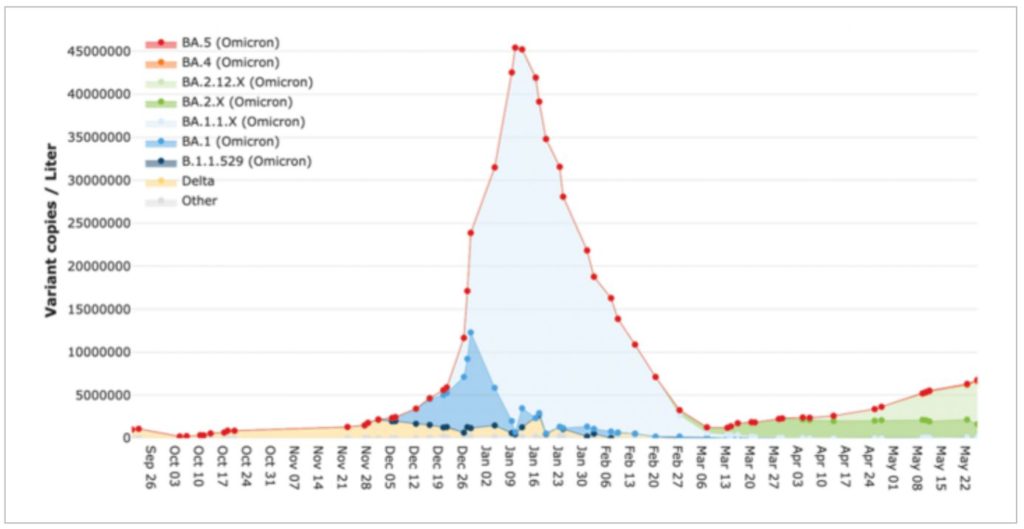Although it is more smelly than other methods of monitoring COVID-19, studying wastewater is a cheaper, faster, and more accurate means for public health officials and academics to discover increased infections.
SARS-CoV-2 virus pieces are flushed down toilets and washed down sinks by infected individuals; the presence of more virus copies in sewage indicates that more people are sick. But until now, most ways of looking at wastewater put all SARS-CoV-2 viruses in the same group.
Now, scientists from Scripps Research and the University of California, San Diego, in partnership with the San Diego Epidemiology and Research for COVID Health (SEARCH) alliance, have improved this condition.
The team reports that using just two tablespoons of raw sewage, they can precisely assess the genetic combination of SARS-CoV-2 variants prevalent in a community and discover novel variants of concern up to fourteen days before traditional clinical testing. The team discovered the Omicron variant in San Diego wastewater 11 days before it was first noted clinically.
Their “Freyja” algorithm for finding SARS-CoV-2 variants in wastewater was published today in Nature. It has already been used by many public health labs and is a big help to efforts to find new SARS-CoV-2 variants.
According to Kristian Andersen, PhD, professor of Immunology and Microbiology at Scripps Research and a senior author of the current study, “In a lot of places, standard clinical surveillance for new variants of concern is not only slow but extremely cost-prohibitive.” But with this new technology, you can effectively characterize the entire city with only one wastewater sample.
Hospitals, state and municipal governments, sequencing facilities, and university scientists—including those in the Andersen lab and the lab of UC San Diego microbiologist Rob Knight, PhD—all had to work closely together on the project.
The Knight lab used 131 wastewater autosamplers to collect wastewater from 343 buildings on the UCSD campus and 17 public schools in 4 San Diego school districts. They also got samples from large wastewater treatment facilities in the county. The team examined more than 20,000 wastewater samples over the course of almost a year.
During this process, they came up with better ways to concentrate viral RNA in wastewater. These methods are now used by public health labs all over the country and the world. Then, the Andersen lab took on the hard task of figuring out how many different kinds of virus there were based on the sequencing data.
As a co-first author of the new paper with Smruthi Karthikeyan of UC San Diego, Scripps Research postdoctoral fellow Joshua Levy, PhD, notes, “It’s challenging to take all these tiny pieces of virus floating around in wastewater and figure out which ones are from different variants and what their relative abundance is.”
Omicron and Delta are two examples of SARS-CoV-2 variants that differ by a modest number of mutations. Public health authorities must nevertheless closely monitor these modifications since they may have an impact on how the virus spreads or infects people.
Usually, they did this by sequencing the virus genomes of patients. This is a slow and expensive process that is less effective at capturing the number and variety of COVID-19 variants as more people use at-home tests.
Based on brief RNA fragments that are specific to each variant, Levy created a library of “barcodes” that categorize SARS-CoV-2 variants. In order to discover these barcodes, he then programmed a new computer tool that sorts through the vast amount of genetic data in wastewater. He made Freyja simple and free.
“If you’re in a lab that can already sequence a wastewater sample, you’re good to go— you just run this code and in another 20 seconds you’re done,” he adds.
Freyja was used by the researchers to analyze wastewater samples, and when they compared the results to clinical information gathered by SEARCH from San Diego’s surrounding areas, they found that the tool had the ability to identify potentially dangerous variants such as Alpha, Delta, and Omicron up to 14 days before it was clinically recognized.

On July 27, 2021, the Mu (B.1.621) variant was found in UC San Diego wastewater—four weeks before it was clinically discovered on campus. Additionally, the team reported that the Omicron variant could be found at the Point Loma wastewater treatment plant on November 27, 2021, 11 days prior to its clinical detection in the city, with an abundance of just over 1% of all SARS-CoV-2 viruses in a contributing population of more than two million people.

According to Karthikeyan, “Wastewater contains a massive amount of very valuable information about our health, including these viral genomes that can let us track the course of a pandemic or epidemic.”
The researchers say that they are still improving the tools they use to look for viruses in wastewater, but that the current set of tools is already a big step up from what was used before. Other human infections could also be tracked using the same techniques, in addition to SARS-CoV-2 variants.
Levy adds: “When you rely on clinical sampling, you not only introduce a lot of socioeconomic and geographic bias into who is contributing to genomic surveillance data, but you also have the problem of asymptomatic people not getting tested and those who only use home tests not contributing to the pool of data. But with wastewater, we don’t have those blind spots.”
Image Credit: Getty
You were reading: A New Way To Detect Rising COVID-19 Cases, SARS-COV-2 Variants – US Researchers
